
The British Museum is a public museum dedicated to human history, art and culture located in the Bloomsbury area of London. Its permanent collection of eight million works is the largest in the world. It documents the story of human culture from its beginnings to the present. The British Museum was the first public national museum to cover all fields of knowledge.

A torc, also spelled torq or torque, is a large rigid or stiff neck ring in metal, made either as a single piece or from strands twisted together. The great majority are open at the front, although some have hook and ring closures and a few have mortice and tenon locking catches to close them. Many seem designed for near-permanent wear and would have been difficult to remove.

The Urnfield culture was a late Bronze Age culture of Central Europe, often divided into several local cultures within a broader Urnfield tradition. The name comes from the custom of cremating the dead and placing their ashes in urns, which were then buried in fields. The first usage of the name occurred in publications over grave sites in southern Germany in the late 19th century. Over much of Europe, the Urnfield culture followed the Tumulus culture and was succeeded by the Hallstatt culture. Some linguists and archaeologists have associated this culture with the pre-Celtic language, or a Proto-Celtic language family.

A lock ring, also spelled lock-ring, is a late Bronze Age penannular hair ornament. Typically in gold, the intricate, decorative jewellery is recognized for its highly skilled workmanship. The name is derived from its suggested use as a hair fastener. Lock rings most likely originated in Ireland in the mid-eighth century B.C. They continued to be manufactured in Ireland, primarily in the River Shannon area into the seventh century B.C. Lock rings from the late Bronze Age have also been found in Great Britain and France.

Bonar Bridge is a village on the north bank of the Kyle of Sutherland to the west and the Dornoch Firth to the east in the Parish of Creich in the Highland council area of Scotland.

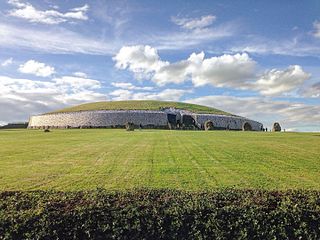
The prehistory of Ireland has been pieced together from archaeological evidence, which has grown at an increasing rate over the last decades. It begins with the first evidence of permanent human residence in Ireland around 10,500 BC and finishes with the start of the historical record around 400 AD. Both the beginning and end dates of the period are later than for much of Europe and all of the Near East. The prehistoric period covers the Palaeolithic, Mesolithic, Neolithic, Bronze Age and Iron Age societies of Ireland. For much of Europe, the historical record begins when the Romans invaded; as Ireland was not invaded by the Romans its historical record starts later, with the coming of Christianity.

The Eberswalde Hoard or Treasure of Eberswalde is a Bronze Age hoard of 81 gold objects with a total weight of 2.59 kg (83 ozt). The largest prehistoric assembly of gold objects ever found in Germany, it is considered to be one of the most important finds from the Central European Bronze Age. Its production has been attributed to the Nordic Bronze Age culture. Today, it is in Russia, as part of the group of artifacts and works of art looted from Germany at the end of the Second World War.

The Dacian bracelets are bracelets associated with the ancient people known as the Dacians, a distinct branch of the Thracians. These bracelets were used as ornaments, currency, high rank insignia and votive offerings Their ornamentations consist of many elaborate regionally distinct styles. Bracelets of various types were worn by Dacians, but the most characteristic piece of their jewelry was the large multi-spiral bracelets; engraved with palmettes towards the ends and terminating in the shape of an animal head, usually that of a snake.
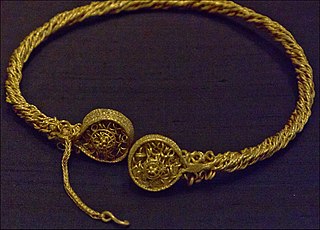

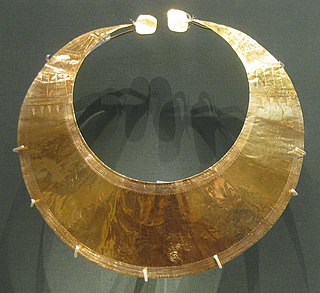
Gold working in the Bronze Age British Isles refers to the use of gold to produce ornaments and other prestige items in the British Isles during the Bronze Age, between circa 2500 and c.800 BCE in Britain, and up to about 550 BCE in Ireland. In this period, communities in Britain and Ireland first learned how to work metal, leading to the widespread creation of not only gold but also copper and bronze items as well. Gold artefacts in particular were prestige items used to designate the high status of those individuals who wore, or were buried with them.

Prehistoric art in Scotland is visual art created or found within the modern borders of Scotland, before the departure of the Romans from southern and central Britain in the early fifth century CE, which is usually seen as the beginning of the early historic or Medieval era. There is no clear definition of prehistoric art among scholars and objects that may involve creativity often lack a context that would allow them to be understood.
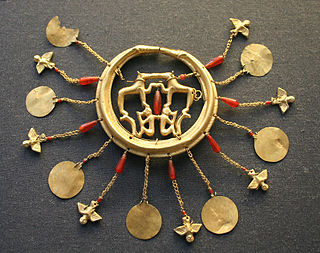
The Aegina Treasure or Aigina Treasure is an important Minoan gold hoard said to have been found on the island of Aegina, Greece. Since 1892, it has been part of the British Museum's collection. It is one of the most important groups of Minoan jewellery.
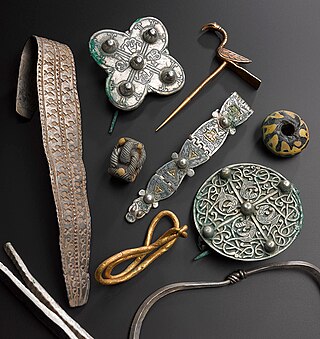
The Galloway Hoard, currently held in the National Museum of Scotland, is a hoard of more than 100 gold, silver, glass, crystal, stone, and earthen objects from the Viking Age discovered in the historical county of Kirkcudbrightshire in Dumfries and Galloway in Scotland in September 2014. Found on Church of Scotland land, the hoard has been described by experts as "one of the most significant Viking hoards ever found in Scotland". With years of extensive study and research, scholars are still not certain who buried the hoard, why they did so and whether they were Vikings or Anglo-Saxons. During the Viking Age, Galloway found itself squeezed between two Viking kingdoms and essentially cut off from other Anglo-Saxons in Britain - "Galloway is where these different cultures were meeting. It’s not just Scandinavians, but people from Britain and Ireland as well."

The Tell el-Ajjul gold hoards are a collection of three hoards of Bronze Age gold jewellery found at the Canaanite site of Tell el-Ajjul in Gaza. Excavated by the British archaeologist Flinders Petrie in the 1930s, the collection is now mostly preserved at the British Museum in London and the Rockefeller Museum in Jerusalem. The treasure ranks amongst the greatest Bronze Age finds in the Levant.

The Mooghaun North Hoard or Great Clare Find is the name of an important Bronze Age hoard found at Mooghaun North, near Newmarket-on-Fergus in County Clare, Ireland. Considered one of the greatest Bronze Age hoards of gold ever found north of the Alps, unfortunately most of the treasure was melted down soon after its discovery. What remains of the hoard is currently split between the National Museum of Ireland in Dublin and the British Museum in London. It is no. 11 in A History of Ireland in 100 Objects.
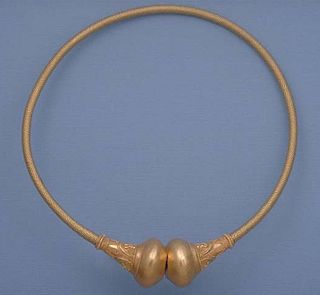
The Havor hoard is an Iron Age treasure found in 1961, in Hablingbo on the Swedish island of Gotland. It consists of a large gold torc, known as the Havor Ring, along with several well-preserved bronze objects and was buried inside a Roman bronze situla in the mound surrounding a hillfort.
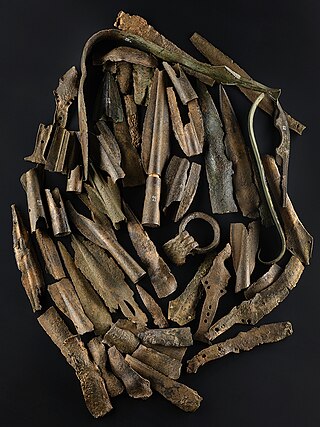
The Duddingston Loch Hoard, currently held by National Museums Scotland (NMS), comprises Late Bronze Age weapons and other objects which were found in Duddingston Loch in Edinburgh when workers were dredging for marl in 1778. The bronze objects were found along with human bones and animal horns.